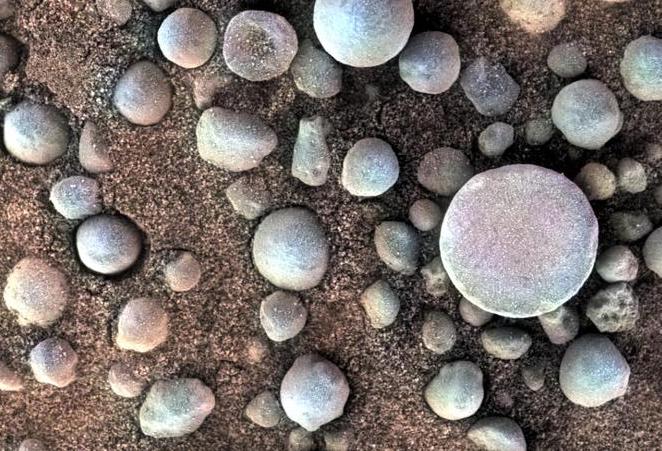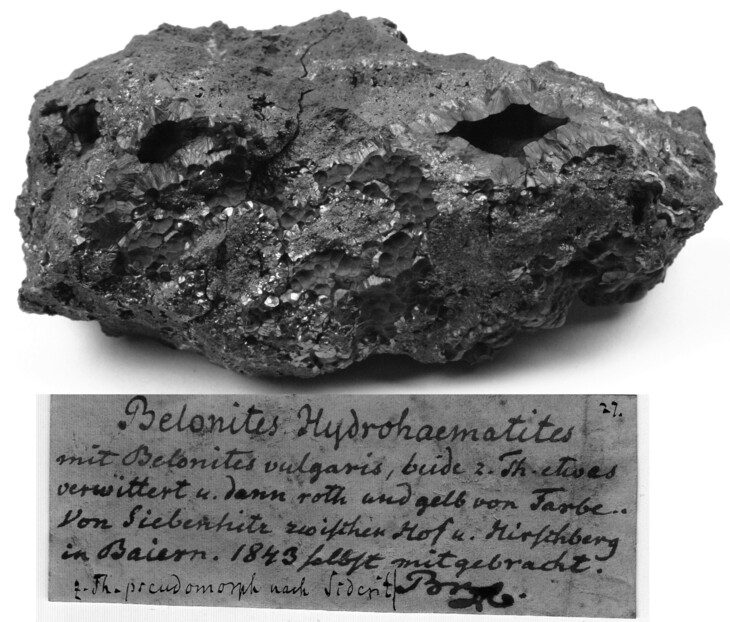Martian 'blueberries' may hold signs of ancient water, new study suggests
These tiny stones could hold the ultimate evidence of Mars' watery past.

The surface of Mars is dotted with millions of tiny, spherical crystals averaging about a tenth of an inch (2.5 millimeters) in diameter. Even though these teensy spherules help give the Red Planet its rusty color, their seemingly blue appearance in a false-color NASA image from 2004 has earned them the nickname "blueberries."
Desperate astronauts trying to juice these "berries" will be disappointed to learn that they are actually hematite — mineral compounds composed of iron and oxygen. However, a new analysis of similar minerals on Earth suggests that this may not always have been the case. According to a new study, the blueberry stones of Mars may really be hydrohematite — iron oxide minerals that also hold microscopic traces of ancient water.
If that's the case, then the blueberry fields of Mars add up to a "substantial water reservoir," the researchers wrote, providing further evidence that the Red Planet was once wet and blue.
"Much of Mars' surface apparently originated when the surface was wetter and iron oxides [like the blueberries] precipitated from that water," study co-author Peter Heaney, a professor of geosciences at Penn State University, said in a statement. "But the existence of hydrohematite on Mars is still speculative."
Related: Mars may hide oceans of water beneath its crust, study finds

Inside the blueberries
In their new study, Heaney and his colleagues examined a variety of hydrohematite samples from the mineral collections at the Smithsonian Institution and Penn State. The team studied the composition of the minerals using various techniques, including X-ray and infrared scans, and confirmed that the minerals had some of their iron atoms replaced with hydroxyl — a hydrogen and oxygen group that comes from stored water.
Next, the team wanted to learn the conditions under which hydrohematite forms, and see if it matched up to the potential conditions that might have once existed on Mars. After subjecting samples to a variety of temperature, acidity and water conditions, the team learned that hydrohematite crystallizes in watery, acidic environments at temperatures lower than 300 degrees Fahrenheit (150 degrees Celsius).
Sign up for the Live Science daily newsletter now
Get the world’s most fascinating discoveries delivered straight to your inbox.
In other words, hydrohematite crystals could have possibly formed out of the watery conditions of ancient Mars, forming a sedimentary layer of tiny iron pebbles all across the planet. Thus, each of the rocky, red "blueberries" on Mars may contain as much as 8% water by weight.
"On Earth, these spherical structures are hydrohematite, so it seems reasonable to me to speculate that the bright red pebbles on Mars are hydrohematite," Heaney said.
The key word here is "speculate." Despite the visual similarities between hydrohematite on Earth and the Martian blueberries, there's no definitive evidence that the blueberries contain water. When NASA's Opportunity rover first discovered the blueberries in 2004, it had no way of determining whether the stones were made of hematite or hydrohematite — and current-generation rovers like Perseverance don't either.
Until future missions can bring pristine mineral samples back from the Red Planet, scientists can only guess at what lurks winthin the red stones.
The findings were published July 20 in the journal Geology,
Originally published on Live Science.

Brandon is the space/physics editor at Live Science. His writing has appeared in The Washington Post, Reader's Digest, CBS.com, the Richard Dawkins Foundation website and other outlets. He holds a bachelor's degree in creative writing from the University of Arizona, with minors in journalism and media arts. He enjoys writing most about space, geoscience and the mysteries of the universe.









